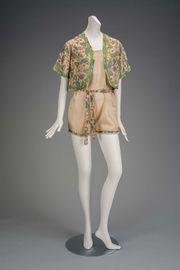Difference between revisions of "Habutai"
Jump to navigation
Jump to search
| (2 intermediate revisions by 2 users not shown) | |||
| Line 1: | Line 1: | ||
| + | [[File:Silk Habutai 201323913.jpg|thumb|Silk Habutai<br>MFA#2013.239.1-3]] | ||
== Description == | == Description == | ||
| Line 7: | Line 8: | ||
habutae ;habutaye; habatae; China silk; Japanese silk; tela de seda cruda (Esp.); Japanse zijde (Ned); | habutae ;habutaye; habatae; China silk; Japanese silk; tela de seda cruda (Esp.); Japanse zijde (Ned); | ||
| − | == | + | ==Resources and Citations== |
* G.S.Brady, ''Materials Handbook'', McGraw-Hill Book Co., New York, 1971 Comment: p. 722 | * G.S.Brady, ''Materials Handbook'', McGraw-Hill Book Co., New York, 1971 Comment: p. 722 | ||
Latest revision as of 12:41, 30 August 2022
Description
A soft, plain weave fabric made with unweighted raw Silk which gives the fabric an uneven texture. Habutai was originally woven in Japan on hand looms. The cloth is sold by weight where 3-4 momme is sheer and 12 momme is heavyweight. Imitation habutai fabric is made using silk warp threads with a rayon weft. Habutai is used for dresses, blouses, handkerchiefs, lamp shades, sheets, and parachutes.
Synonyms and Related Terms
habutae ;habutaye; habatae; China silk; Japanese silk; tela de seda cruda (Esp.); Japanse zijde (Ned);
Resources and Citations
- G.S.Brady, Materials Handbook, McGraw-Hill Book Co., New York, 1971 Comment: p. 722
- Random House, Webster's Encyclopedic Unabridged Dictionary of the English Language, Grammercy Book, New York, 1997
- Fairchild's Dictionary of Textiles, Phyllis G.Tortora, Robert S. Merkel (eds.), Fairchild Publications, New York City, 7th edition, 1996
- Edward Reich, Carlton J. Siegler, Consumer Goods: How to Know and Use Them, American Book Company, New York City, 1937
